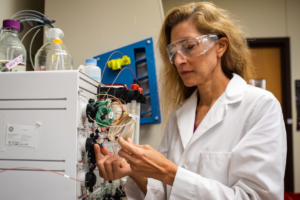Thomas Smith (b. 1938), visual effects producer for such films as “Star Wars: Empire Strikes Back” and “E.T.: The Extra Terrestrial,” has donated his archive to the Harry Ransom Center, a humanities research library and museum at The University of Texas at Austin. Smith was hired by George Lucas as the first head of Industrial Light and Magic (ILM) and worked on the special effects for such films as “Raiders of the Lost Ark,” “Star Trek III: The Search for Spock,” “Star Wars: Return of the Jedi,” “Indiana Jones and the Temple of Doom” and “Honey, I Shrunk the Kids.”
“Tom Smith’s collection will be of tremendous interest to students and scholars studying special effects in film and its impact on our culture,” said Steve Wilson, curator of film at the Ransom Center. “His work and the films he helped create will be studied for generations to come, and we’re grateful for this generous and important gift.”
The Smith collection comprises 22 boxes and documents Smith’s professional work through the 1980s and 1990s. Spanning from 1979 to 2003, the collection contains special effects storyboards, screenplay drafts, scripts, pre-production research, production materials, newspaper clippings, photographs and published materials such as fan magazines and cinematography periodicals. The papers also contain material relating to Smith’s time at ILM and Lucasfilm.
After graduating from Northwestern University in 1960, Smith studied film in Paris at the Institute of Higher Studies in Film with the help of a Fulbright Scholarship. Following three years in the U.S. Air Force, Smith began his career in film as a writer and producer-director for Encyclopaedia Britannica Educational Corporation (EB), where he directed more than 50 educational films. One of Smith’s last projects for EB changed the trajectory of his career to special effects. “Solar System” not only allowed Smith to experiment with special effects, it also caught the eye of George Lucas, American filmmaker and founder of Lucasfilm.
Smith began working for Lucas’s ILM in 1980 and oversaw the visual effects facility through 1986. After that, Smith worked in freelance special effects and produced films for Lucasfilm, Disney, Jim Henson and Turner Broadcasting System. He won a British Academy Award for outstanding visual effects on “Honey, I Shrunk the Kids” and produced several theme park attractions for Disney. Smith went on to work for Disney until 1992. Since then he has worked on several other projects, including his own feature film “The Arrival.”
Highlights of the Smith collection include storyboards from “Return of the Jedi,” a copy of the “Dick Tracy” script with annotations by Warren Beatty and sequential storyboards for “Raiders of the Lost Ark.”
“There are few artistic endeavors that call upon so many disciplines as the production of feature films,” said Smith. “While the average filmgoer is aware of the actors and some of the crew behind the camera, hundreds of craftsmen and artists put their work into the planning and producing of every large film. Most of the work is either never seen by the audience or remains in the background. Fortunately I saved some of my documents, and that is what makes up the collection I have donated to the Harry Ransom Center.”
Smith will visit The University of Texas at Austin to speak publicly on Thursday, April 19, at 7 p.m. in KLRU’s Studio 6A in the Communications Center Building B. As part of the Harry Ransom Lecture series, Smith will discuss his life and career. While on campus, Smith will also meet with students in the College of Communication’s Department of Radio-Television-Film.
The Thomas G. Smith Endowment has been established at the Ransom Center to support research in the collection. Information about the Ransom Center’s fellowships is available online.
Other film collections at the Ransom Center include those of producer David O. Selznick; actor, producer and director Robert De Niro; screenwriters Paul Schrader, Ernest Lehman and Jay Presson Allen; actress Gloria Swanson; and early special effects creator Norman Dawn.
The collection will be made accessible once it is processed and cataloged.




